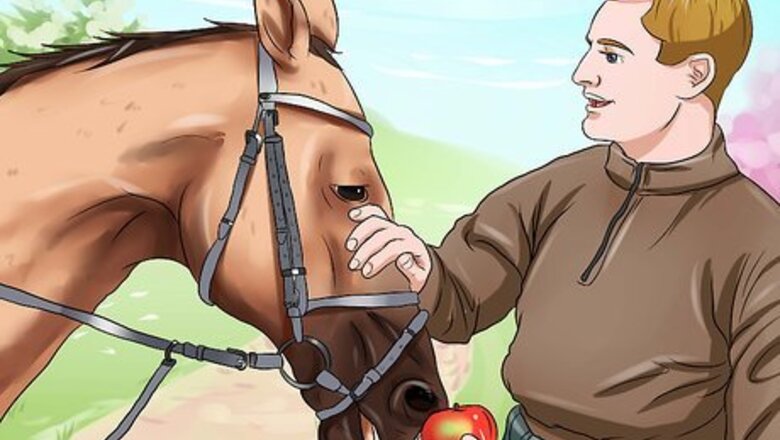
views
X
Expert Source
Kate JutagirEquestrian Specialist & Trainer
Expert Interview. 31 March 2020.
A "head shy" horse will pull away when you try to pat its head. You can get a head shy horse to trust you with patience and calm training.
Using Reinforcement
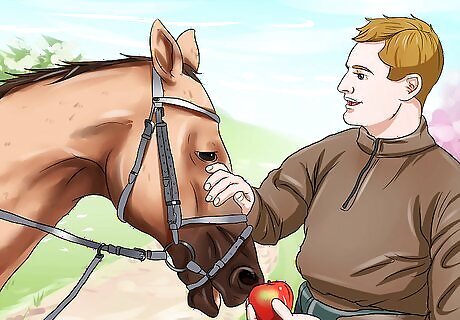
Teach your horse that your touch can be trusted. A head shy horse has learned to avoid a human touch, whether because of maltreatment or accident. Your horse must be taught that human touch is a good thing. Behavioral training teaches this by associating the desired behavior with a reinforcement, or reward. The steps of behavioral training require time and patience. Teaching your horse to keep her head quiet when approached is the observable behavior that you can work on. Trust is something that can only develop over time. Don't engage in behavioral training unless you're feeling calm and confident. If you lose your temper during this process, all the efforts you've put into training will be useless. It's essential that the behavior training is done in a consistent manner.
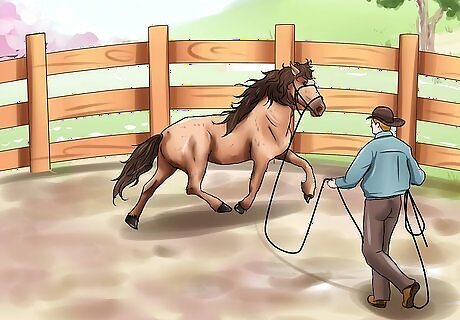
Bring your horse to a round enclosed field or small paddock. Lead your haltered horse with a soft rope or lunge line. Once inside the field, take the lead off and place it outside the fence. 35-foot diameter paddock is the minimum safe area for working with your horse, though it can be as large as 60 feet. Keep the paddock free of other distractions, loud noises, other animals, etc. The horse should feel safe and comfortable.
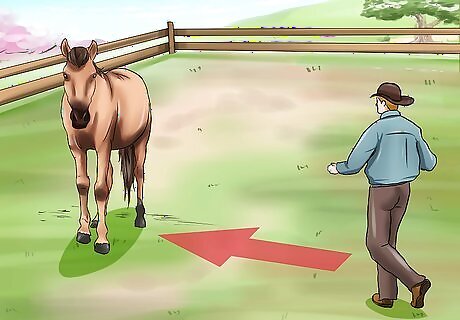
Approach your horse from the side. Walk at a steady rate of speed, neither fast nor slow. Keep your body relaxed. If you're tense, the horse will likely pick up on that. Do not make eye contact with a nervous horse. Instead, place your gaze near her knee or lower body. Wait until the horse shows that she's open to being touched. She might turn towards you, lick her lips or soften her eyes. If your horse gives signs of not wanting to be touched, such as turning her head away or walking away, respect this. Never force touch on an animal.
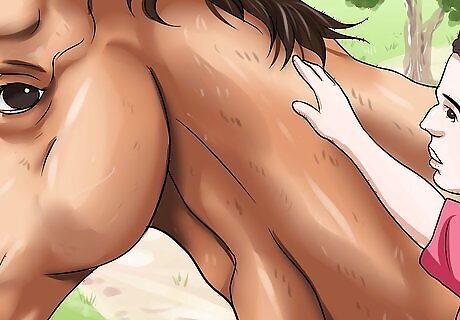
Put your hand to your horse's neck or shoulder gently but firmly. This isn't a rub or a pet, but simply a light touch. If your horse tenses or shies away, drop your hand and walk away. This is done for purposes of assessment. If, at the end of this assessment, your horse easily allows you to touch her, move your touch closer to her head. If she doesn't allow you to touch her closer to her head, go back to the area where she was comfortable with your touch. The trick is to go at her rate of speed in order to develop trust. Only allowing brief touches will encourage your horse to trust you. She may be overwhelmed by longer touches. She will learn that you respond quickly to her pulling away from an unwanted touch.
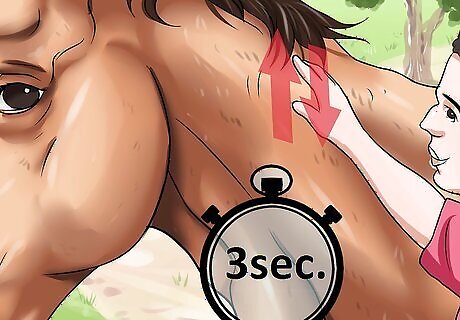
Stroke your horse gently. With your fingers, follow the direction of her hair in a rubbing motion. This is a brief petting, about 3 seconds. Then walk away, as before. Again, you're teaching your horse that you are a safe person. Your touch is safe, but firm. Through repetition, you can move your hand closer and closer to the areas of her head she may not have allowed you to touch before. Over time, you can keep your hand on your horse for a longer time. 3 seconds can increase to 4 seconds, then to 5. If she shies away, you'll know you've gone too fast. Go back to the amount of time she's comfortable with and try again.
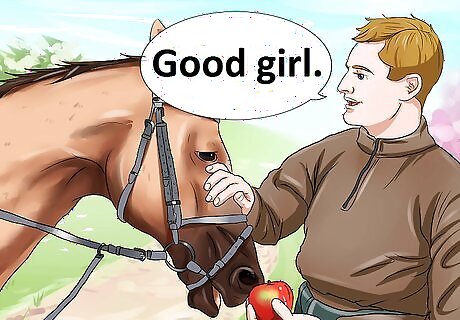
Give her a treat to reward her trust. As soon as you feel her relax beneath your touch, remove your hand and offer her a treat.With one hand on her head, say, "Good girl!" or whistle to her softly. You'll want to reinforce the trusting behavior while it's happening, so that the behavior and the reinforcer are strongly connected. The sound of your affirming whistle or voice serves as a way to draw the horse's attention to what's happening at that moment. If she's relaxed, even for a very small time, you can draw her attention to that relaxation. Hold a treat in the hand that's not touching the horse. If the horse tenses, even briefly, do not pursue her. Pause, or walk away.
Using Desensitization and Counterconditioning
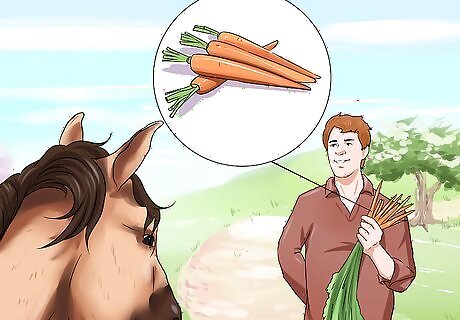
Teach your horse to associate your presence with treats. At this point, do not attempt to touch her. Simply stand in front of her, slightly to her left, and offer her a treat with your open hand. Desensitization starts with simply being present in the vicinity of your horse's face. She will learn to associate your presence with something positive. Work slowly, and allow the horse to direct the speed of progress. This will build trust. After doing this several times, bring the treat within six inches of her muzzle. Then, drop your hand. She'll likely follow your hand with her head. Say "Yes," or "Good Girl," and offer her the treat. Do this several times, so that she learns to connect your hand and your words (or, to her, sound) with the treat.
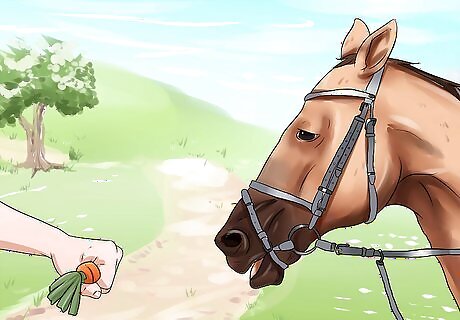
Pause before giving her the treat. When she has made the connection between your hand and the treat, she will expect it. You are teaching her to desire your hand, because it contains the treat. Hold this hand, palm down, fingers wrapped around the treat. When your horse lowers her head toward your other hand, let her have the treat. Raising the head can be a sign of anxiety, and reinforcing a lowered head teaches her to be calm.
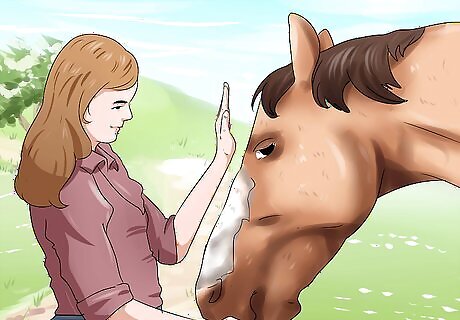
Lift your other hand, palm open, towards her head. Do not touch your horse, but simply hold your hand in place. This will teach your horse that having your hand in this area, close to her head, isn't dangerous. Although currently, this is something fearful for your horse, she can learn that having someone's hand here isn't always bad. Repeat this many times over several days, until you're sure that your horse is aware of your hand and yet not bothered by it. Continue to wait until she lowers her head to reward her with a treat.
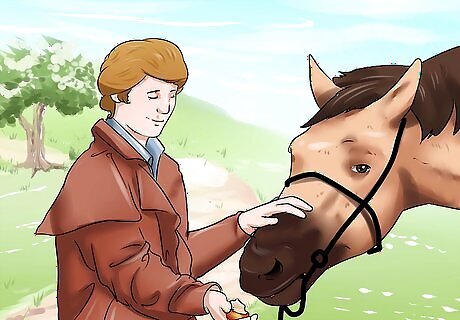
Touch your horse as she eats. When your horse has gained comfort with your hand near her head, you can start to touch her on her muzzle. Put your raised hand on the bridge of your horse's nose, below her eyes, as she eats her treat. Speak to her in a gentle, reassuring voice. As your horse finishes eating, she may try to pull away. Try to keep your hand on her muzzle until she relaxes. At the moment she relaxes, say, "Yes" and pull your hand away. Repeat this step until your horse seems relaxed with your hand on her muzzle.
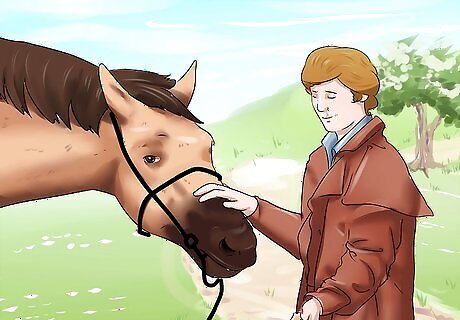
Touch your horse before offering the treat. Follow the same procedure as before, gently but firmly setting your hand to your horse's muzzle. Continue to keep the hand containing the treat low, so that she must lower her head to accept it. When she relaxes, say, "Yes," and give her the treat, and release your touch.
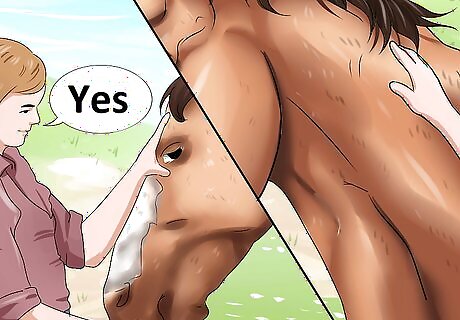
Move your touch to other parts of your horse's muzzle and head. Continue to wait for her to relax before offering the treat with your other hand. When she relaxes, say, "Yes," and offer her the treat. Move slowly, gradually expanding the range of your touch, as you teach her to trust you on all areas of her head. Start to stroke or massage your horse's head for a few seconds below her muzzle, before she gets her treat.
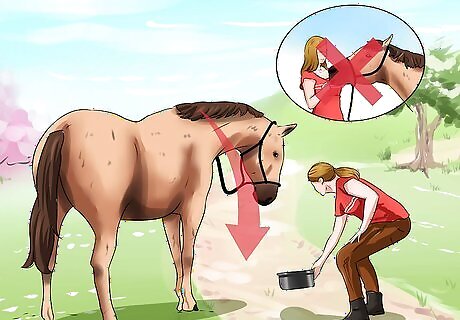
Vary your training sessions. Horses, like other animals, don't necessarily generalize well. For best teaching, train your horse in these steps on different times of the day, and in different places. Lowering her head should continue to be met with a treat in your palm. Don't offer her a treat unless her head is lowered. When your horse is comfortable with your hand, start to teach her to trust the feel of cloth, or grooming instruments. Use the same training procedures as before.
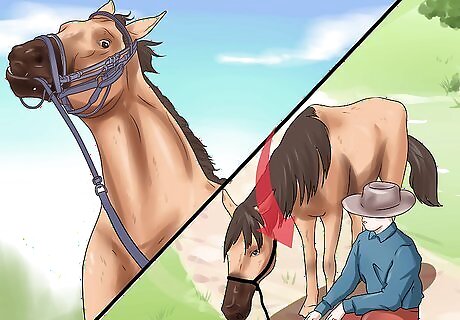
Be a leader for your horse. This will further your horse's sense of trust in you. Horses are a pack animals, and require a leader to feel safe and protected. Establishing leadership isn't about being dominant, but about establishing yourself as leader of the herd. Correct your horse when she tests boundaries. Your goal is to make sure your horse knows who is in charge. When your horse is confident that you're in charge, she'll likely stop testing boundaries. When your horse is fearful, encourage her to lower her head. A lowered head automatically relaxes a horse. Your horse may then learn to associate the feeling of relaxation and safety with you.
Building Trust
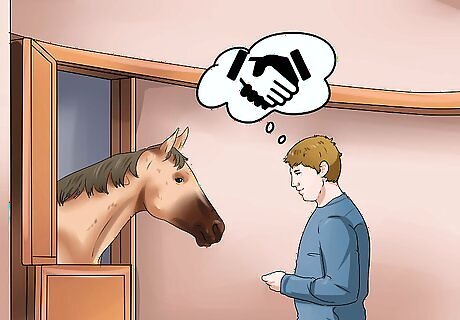
Be positive. Your horse is sensitive to your emotional state. She'll be quick to pick up on your irritability or frustration. If you've decided that your horse is difficult, then she will be. Instead, approach your horse with a feeling of optimism and trust. This will increase the chances that she'll respond in the same way! Talk to your horse frequently, whenever you're in the pen. Give her a nickname that describes the best way she can be, rather than focusing on her more difficult qualities. Remember that a relationship, whether with a horse or with a person, always has two partners. Knowing your own weaknesses as a trainer will help you from blaming your horse for behaviors which are yours. Spending more time with your horse will help develop a positive relationship. Hang out with your horse, even if you're just reading a book in her stall, or cleaning the barn nearby. She should get used to your presence, and associate it with good things. Talk to your horse frequently and reassuringly.
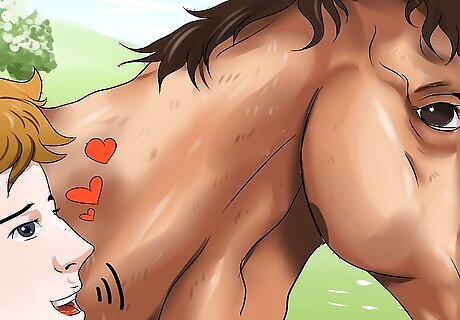
Use a kind voice with your horse. When talking with your horse, your voice should always be kind and positive. Never shout at your horse in an angry voice. Communication happens verbally and nonverbally. All communication with your horse should be kind. An violent yank on a halter, or a jerk on the reins, communicates angrily to your horse. This erodes trust, and should be avoided. Make sure your communication with your horse is clear, concise and consistent. Good grooming for your horse provides a daily opportunity to bond. Brushing your horse, caring for her hooves, combing her mane are all opportunities to practice positive communication.
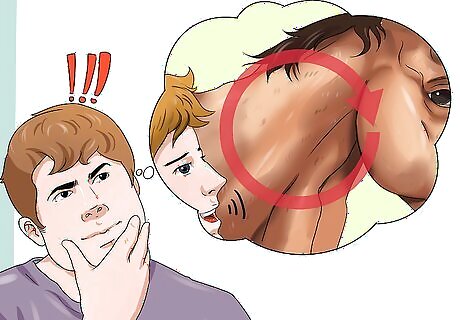
Build credibility through consistency. Developing consistent patterns of behavior will help increase your horse's ability to trust you. If you're predictable to your horse, your horse will be more likely to trust you. Pay attention to the praise you offer your horse. Is your praise being consistently directed? Or are you more often praising your horse based on your own good mood? If you are directing corrections to your horse, does it make sense to your horse? Make sure you're using consistent directions when asking your horse to do something. Remember, even though your horse may be learning to respond to your commands, your horse does not - and never will! - be fluent in spoken language! Use consistent commands, both verbal and nonverbal, to get consistent results.
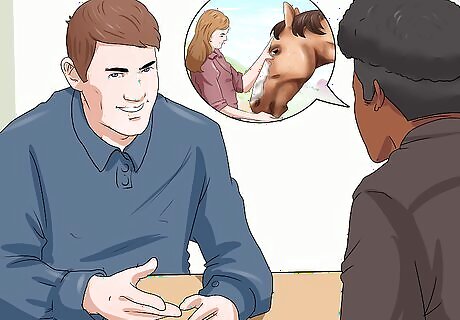
Ask for professional help. Even the best trainers can sometimes get stuck. Sometimes the most effective way to work through a situation with a head shy horse can be to ask a friend, another trainer, or a professional instructor for help. Another person may be able to see a pattern that we couldn't. There are support groups for horse owners. Many horse owners will have come across the same challenges you face, and they're eager to share their experience. Search online for local area groups, or participate in online groups. Ask at your local stables or horse clubs. Volunteer to help others. It's easier to have a clear perspective on situations you're not emotionally involved in. Helping another horse owner with their situation may result in fresh insights regarding your own pattern of behavior with your horse.




















Comments
0 comment